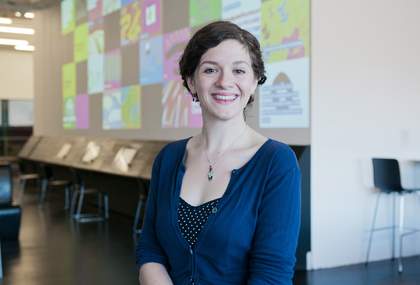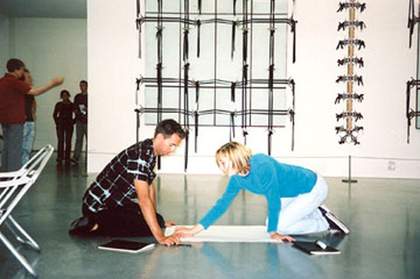
Minnie Scott, Curator of Interpretation, at the new Bloomberg Connects creative spaces at Tate ModernPhoto: Lucy Dawkins, Tate Photography
The word used to describe my role, my team and what we do is potentially rather misleading. I’m a curator in the Interpretation department - but ‘interpretation’ suggests that we tell visitors what artworks mean and what to think of them. The word is associated with translation too, so there’s the implication that art is a foreign language to most people and that some sort of interpreter is needed to make sense of it. All this actually goes against what we’re really trying to do.
Our team works on captions, wall panels and leaflets; audio guides, multimedia guides and apps. We work closely with exhibition curators, finding ways to communicate their deep expertise on specific areas in a way that is accessible to visitors who are totally new to the subject, and yet still relevant to others who come in with lots of pre-existing knowledge of the field.
I think what’s most important is that you feel at ease in a gallery. I’ve been to museums that made me feel stupid and unwelcome because I arrived unfamiliar with their subject (and left in much the same state). Giving visitors the impression that their knowledge and even their taste are on trial can’t be conducive to enjoyment or learning. Interpretation is about providing relevant information – art historical, social, material – that different people can use in different ways to help them make meaning from what they’re looking at. Our work is also about making it clear that there are many ways to look at an artwork and that your own experiences are always valid reference points.
I came to Interpretation following studying English Literature at university, then did my Masters at Georgetown University in Washington, DC - where I studied literature again, along with Culture, Communication and Technology. After that I was a curatorial fellow in the Whitney Independent Study programme in New York for a year, then moved to London where (after more internships and being a canapé waitress) I started working at Tate. I’ve been working here (at both Tate Britain and Tate Modern) since 2008. I was initially drawn to the combination of art and writing that a job in Interpretation offered. This is still something that fascinates me, but my years at Tate have made me think more broadly about how people engage with art.
These days, ‘visitor-generated interpretation’ is a bit of a catch-phrase in museums. I’d like to think that all interpretation is generated by visitors – we’re just providing some tools that can help. But the phrase is used specifically to mean sharing visitors’ ideas and responses with others, and I believe this can be hugely enriching. At Tate Modern, we’ve just launched a set of new digital interpretation projects – Bloomberg Connects – that have visitors’ voices at their heart. We’re asking people to add their personal thoughts on artworks they’ve seen, give their opinion on art-related debates, submit questions for artists or draw a visual response to something that inspired them during their visit. As well as opportunities for self-expression, these projects are a platform for the insights and ideas of visitors. I’m excited about the gallery increasingly becoming a place for dialogue, not only between visitors and Tate but among fellow visitors who have shared experiences and constructed different interpretations.

